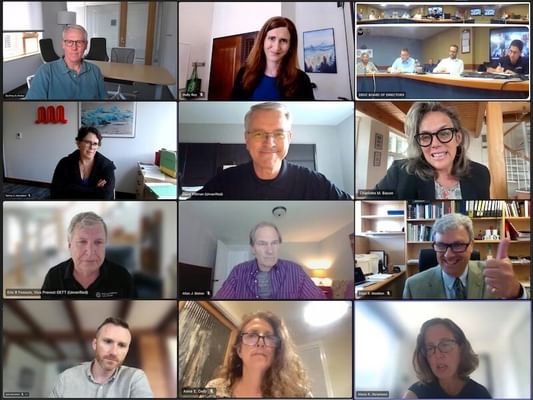- Undergraduate
Bachelor's Degrees
Bachelor of ArtsBachelor of EngineeringDual-Degree ProgramUndergraduate AdmissionsUndergraduate Experience
- Graduate
Graduate Experience
- Research
- Entrepreneurship
- Community
- About
-
Search
All Thayer News

Dartmouth Expands Partnership with US Army Corps Labs
Jul 22, 2024 | Dartmouth News
Dartmouth is broadening and deepening its collaboration with the Engineer Research and Development Center (ERDC) of the US Army Corps of Engineers, building on a long-standing partnership with the Hanover-based Cold Regions Research and Engineering Laboratory (CRREL).

Dartmouth research officials meet with lab directors from the Engineer Research and Development Center of the US Army Corps of Engineers on Thursday, July 18, to discuss the expanded partnership.
CRREL was built on land then owned by Dartmouth in 1961 to help the US meet challenges encountered in the world's coldest environments. For decades, Dartmouth and CRREL have had close research and educational interactions. Building on that legacy, the expanded partnership widens the network beyond Hanover to include ERDC's six other laboratories, each with its own set of research priorities.
On Thursday, top officials from ERDC met with Dartmouth leaders in a video conference to explore synergies between ERDC and Dartmouth researchers, many of whom work at Thayer School of Engineering and the Arthur L. Irving Institute for Energy and Society.
"There's a huge overlap between the interests of our faculty and the interests of the investigators across the ERDC universe," said Dean Madden, vice provost for research and a professor of biochemistry and cell biology. "This is just the first step toward creating the framework for identifying future collaborations."
The new education partnership agreement will multiply career pathways in both directions, recruiting talent to meet some of the most pressing challenges of our time, said ERDC Director David Pittman.
"You're in the business of creating smart people. We're in the business of hiring smart people, so we need your students, graduate students, and undergraduates," he said.
ERDC already employs 13 Dartmouth graduates, and seven ERDC employees hold adjunct teaching positions at Dartmouth.
Participants spotlighting Dartmouth's unique research strengths included Alexis Abramson, dean of engineering; Eric Fossum, Thayer's John H. Krehbiel Sr. Professor for Emerging Technologies and vice provost for entrepreneurship and technology transfer; Geoff Parker, Thayer's Charles E. Hutchinson '68A Professor of Engineering Innovation and interim faculty director, Irving Institute; Jane Lipson, associate dean for the sciences; Charlotte Bacon, assistant vice provost for research development and alliances and director, GrantGPS; and Josh Keniston, senior vice president of capital planning and campus operations.
Keniston told the ERDC team about Dartmouth's sweeping energy decarbonization and infrastructure renewal plan, which Madden later said would benefit from ERDC involvement.
Abramson described Thayer's work in "the energy transition space. We have a lot of work going on in, for example, batteries and power electronics, and are also looking at the integration of the grid with policy and business and the energy systems of the future," she said. "Biofuels is another big area for us, and on the biomedical side we have great strengths in medical devices and biomedical imaging."
Besides CRREL, ERDC-affiliated programs include the Coastal and Hydraulics Laboratory, the Environmental Laboratory, the Geotechnical Structures Laboratory, and the Information Technology Laboratory, all headquartered in VIcksburg, Miss.; the Geospatial Research Laboratory in Alexandria, Va.; and the Construction and Engineering Research Laboratory based at the University of Illinois at Urbana-Champaign.
At these and additional field locations, more than 2,500 researchers and engineers in ERDC's $2.4 billion program advance strategic priorities such as climate change mitigation, military resilience, infrastructure modernization, environmental sustainability, reliable energy installations, cybersecurity, and the study and protection of Arctic regions.
PIttman said Dartmouth and ERDC pursue "common needs or interest in those areas. We have money, but we cannot possibly execute our program by ourselves. I've called it a 'Disney World for engineers and scientists,' but the magic is real. We have real-world problems to solve."
During the meeting, directors of ERDC's labs and faculty from Dartmouth, including Anne Gelb, John G. Kemeny Parents Professor of Mathematics, and Jonathan Winter, associate professor of geography, exchanged information about ongoing projects ripe for collaboration.
"I work broadly on climate impacts on flooding, health, and agriculture," said Winter. "In terms of flooding, I've done a lot of work looking at changes in heavy rainfall events."
Gelb, who specializes in applied mathematics and is also working on sea ice modeling, said her graduate students are eager to become interns at ERDC labs. Pittman raised the possibility of faculty exchanges, as well.
In addition to Pittman and the seven lab leaders, ERDC was represented by Deputy Director Patricia Sullivan and Col. Christian Patterson, commander.
The meeting was followed by a virtual poster session showcasing the work of six Dartmouth researchers, several of whom are investigating the properties of ice. Tara Tomlinson, a third-year PhD candidate in engineering, is a planetary scientist.
"We basically created a novel way to grow space ice in the lab," she told the ERDC team. "We're the only people in the country, as far as I can tell, with a setup like this, that can replicate the kinds of growth that we expect for ices on certain planets."
"You all did a brilliant job," Pittman told the presenters. "Our world-class teams will do great things together."
Link to source:
https://home.dartmouth.edu/news/2024/07/dartmouth-expands-partnership-us-army-corps-labs
For contacts and other media information visit our Media Resources page.
